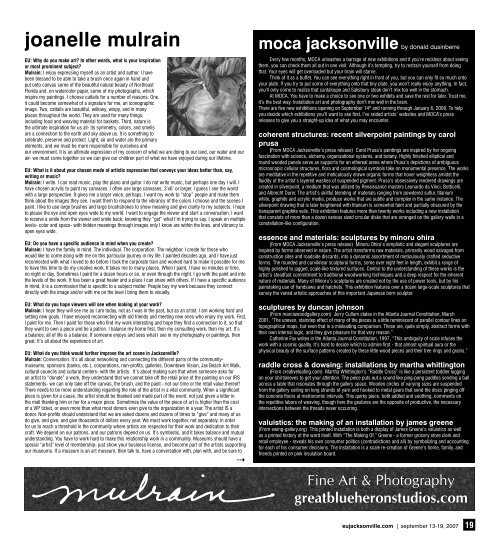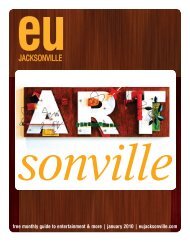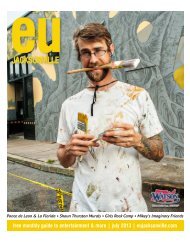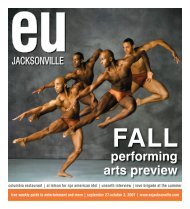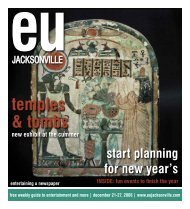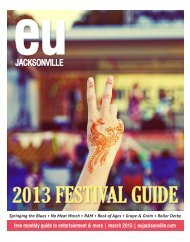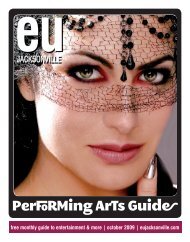view this week's issue in Adobe PDF version - Eujacksonville.com
view this week's issue in Adobe PDF version - Eujacksonville.com
view this week's issue in Adobe PDF version - Eujacksonville.com
You also want an ePaper? Increase the reach of your titles
YUMPU automatically turns print PDFs into web optimized ePapers that Google loves.
joanelle mulra<strong>in</strong><br />
EU: Why do you make art? In other words, what is your <strong>in</strong>spiration<br />
or most prom<strong>in</strong>ent subject?<br />
Mulra<strong>in</strong>: I enjoy express<strong>in</strong>g myself as an artist and author. I have<br />
been blessed to be able to take a brush once aga<strong>in</strong> <strong>in</strong> hand and<br />
put onto canvas some of the beautiful natural beauty of Northeast<br />
Florida and, on watercolor paper, some of my photographs, which<br />
<strong>in</strong>spire my pa<strong>in</strong>t<strong>in</strong>gs. I choose cattails for a number of reasons. One,<br />
it could be<strong>com</strong>e somewhat of a signature for me, an iconographic<br />
image. Two, cattails are beautiful, willowy, wispy, and <strong>in</strong> many<br />
places throughout the world. They are used for many th<strong>in</strong>gs,<br />
<strong>in</strong>clud<strong>in</strong>g food and weav<strong>in</strong>g material for baskets. Third, nature is<br />
the ultimate <strong>in</strong>spiration for us all- its symmetry, colors, and smells<br />
are a connection to the earth and sky above us. It is someth<strong>in</strong>g to<br />
celebrate, preserve and protect. Light, air and water are the primary<br />
elements, and we must be more responsible for ourselves and<br />
our environment. It is an ultimate expression of my concern of what we are do<strong>in</strong>g to our land, our water and our<br />
air- we must <strong>com</strong>e together so we can give our children part of what we have enjoyed dur<strong>in</strong>g our lifetime.<br />
EU: What is it about your chosen mode of artistic expression that conveys your ideas better than, say,<br />
writ<strong>in</strong>g or music?<br />
Mulra<strong>in</strong>: I write. I can read music, play the piano and guitar. I do not write music, but perhaps one day I will. I<br />
have chosen acrylic to pa<strong>in</strong>t my canvases. I often use large canvases, 3’x6’ or larger. I guess I see the world<br />
with a large perspective. It gives me a larger voice, perhaps. I want my work to “stop” people and make them<br />
th<strong>in</strong>k about the images they see. I want them to respond to the vibrancy of the colors I choose and the scenes I<br />
pa<strong>in</strong>t. I like to use large brushes and large brushstrokes to show mean<strong>in</strong>g and give clarity to my subjects. I hope<br />
to please the eye and open eyes wide to my world. I want to engage the <strong>view</strong>er and start a conversation. I want<br />
to receive a smile from the <strong>view</strong>er and smile back, know<strong>in</strong>g they “get” what I’m try<strong>in</strong>g to say. I speak on multiple<br />
levels- color and space- with hidden mean<strong>in</strong>gs through images only I know are with<strong>in</strong> the l<strong>in</strong>es, and vibrancy to<br />
open eyes wide.<br />
EU: Do you have a specifi c audience <strong>in</strong> m<strong>in</strong>d when you create?<br />
Mulra<strong>in</strong>: I have the family <strong>in</strong> m<strong>in</strong>d. The <strong>in</strong>dividual. The corporation. The neighbor. I create for those who<br />
would like to <strong>com</strong>e along with me on <strong>this</strong> particular journey <strong>in</strong> my life. I pa<strong>in</strong>ted decades ago, and I have just<br />
reconnected with what I loved to do before I took the corporate tra<strong>in</strong> and worked hard to make it possible for me<br />
to have <strong>this</strong> time to do my creative work. It takes me to many places. When I pa<strong>in</strong>t, I have no m<strong>in</strong>utes or time,<br />
no night or day. Sometimes I pa<strong>in</strong>t for a dozen hours or so, or even through the night. I go with the pa<strong>in</strong>t and <strong>in</strong>to<br />
the levels of the work. It has been a great healer and a place I can share with others. If I have a specifi c audience<br />
<strong>in</strong> m<strong>in</strong>d, it is a <strong>com</strong>mission that is specifi c to a subject matter. People buy my work because they connect<br />
directly with the image and/or with me on the level I br<strong>in</strong>g them to visually.<br />
EU: What do you hope <strong>view</strong>ers will see when look<strong>in</strong>g at your work?<br />
Mulra<strong>in</strong>: I hope they will see me as I am today, not as I was <strong>in</strong> the past, but as an artist. I am work<strong>in</strong>g hard and<br />
sett<strong>in</strong>g new goals. I have enjoyed reconnect<strong>in</strong>g with old friends and meet<strong>in</strong>g new ones who enjoy my work. First,<br />
I pa<strong>in</strong>t for me. Then I pa<strong>in</strong>t for those who fi nd my work <strong>in</strong>terest<strong>in</strong>g and hope they fi nd a connection to it, so that<br />
they want to own a piece and be a patron. I balance my home fi rst, then my consult<strong>in</strong>g work, then my art. It’s<br />
a balance; all of life is a balance. If someone enjoys and sees what I see <strong>in</strong> my photography or pa<strong>in</strong>t<strong>in</strong>gs, then<br />
great. It’s all about the experience of art.<br />
EU: What do you th<strong>in</strong>k would further improve the art scene <strong>in</strong> Jacksonville?<br />
Mulra<strong>in</strong>: Conversation. It’s all about network<strong>in</strong>g and connect<strong>in</strong>g the different parts of the <strong>com</strong>munity-<br />
museums, sponsors (banks, etc.), corporations, non-profi ts, galleries, Downtown Vision, Jax Beach Art Walk,<br />
cultural councils and cultural centers- with the artists. It’s about mak<strong>in</strong>g sure that when someone asks for<br />
an artist to “donate” a work, they understand that we cannot take off the retail price of the pa<strong>in</strong>t<strong>in</strong>g on our IRS<br />
statements- we can only take off the canvas, the brush, and the pa<strong>in</strong>t - not our time or the retail value thereof!<br />
There needs to be more understand<strong>in</strong>g regard<strong>in</strong>g the role of the artist <strong>in</strong> a vital <strong>com</strong>munity. When a signifi cant<br />
piece is given for a cause, the artist should be thanked and made part of the event, not just given a letter <strong>in</strong><br />
the mail thank<strong>in</strong>g him or her for a major piece. Sometimes the value of the piece of art is higher than the cost<br />
of a VIP ticket, or even more than what most donors even give to the organization <strong>in</strong> a year. The artist IS a<br />
donor. Non-profi ts should understand that we are asked dozens and dozens of times to “give” and many of us<br />
do give, and give, and give thousands of dollars every year. We must work together, not separately, <strong>in</strong> order<br />
for us to reach a threshold <strong>in</strong> the <strong>com</strong>munity where artists are respected for their work and dedication to their<br />
craft. We depend on our patrons, and our patrons depend on us. It’s symbiotic, and it takes balance and mutual<br />
understand<strong>in</strong>g. You have to work hard to make <strong>this</strong> relationship work <strong>in</strong> a <strong>com</strong>munity. Museums should have a<br />
special “artist” level of membership- just show your bus<strong>in</strong>ess license, and be<strong>com</strong>e part of the artists support<strong>in</strong>g<br />
our museums. If a museum is an art museum, then talk to, have a conversation with, plan with, and be sure to<br />
<br />
moca jacksonville by donald dus<strong>in</strong>berre<br />
Every few months, MOCA unleashes a barrage of new exhibitions and if you’re reckless about see<strong>in</strong>g<br />
them, you can check them all out <strong>in</strong> one visit. Although it’s tempt<strong>in</strong>g, try to restra<strong>in</strong> yourself from do<strong>in</strong>g<br />
that. Your eyes will get overloaded but your bra<strong>in</strong> will starve.<br />
Th<strong>in</strong>k of it as a buffet. You can see everyth<strong>in</strong>g right <strong>in</strong> front of you, but you can only fi t so much onto<br />
your plate. If you try to put some of everyth<strong>in</strong>g onto that t<strong>in</strong>y plate, you won’t really enjoy anyth<strong>in</strong>g. In fact,<br />
you’ll only <strong>com</strong>e to realize that cantaloupe and Salisbury steak don’t mix too well <strong>in</strong> the stomach.<br />
At MOCA, You have to make a choice to see one or two exhibits and save the rest for later. Trust me,<br />
it’s the best way. Installation art and photography don’t mix well <strong>in</strong> the bra<strong>in</strong>.<br />
There are fi ve new exhibitions open<strong>in</strong>g on September 14 th and runn<strong>in</strong>g through January 6, 2008. To help<br />
you decide which exhibitions you’ll want to see fi rst, I’ve raided artists’ websites and MOCA’s press<br />
releases to give you a straight-up idea of what you may encounter.<br />
coherent structures: recent silverpo<strong>in</strong>t pa<strong>in</strong>t<strong>in</strong>gs by carol<br />
prusa<br />
(From MOCA Jacksonville’s press release) Carol Prusa’s pa<strong>in</strong>t<strong>in</strong>gs are <strong>in</strong>spired by her ongo<strong>in</strong>g<br />
fasc<strong>in</strong>ation with science, alchemy, organizational systems, and botany. Highly fi nished elliptical and<br />
round wooded panels serve as supports for an ethereal arena where Prusa’s depictions of ambiguous<br />
microscopic cellular structures, fl ora and cosmological symbols take on monumental presence. The works<br />
are meditative <strong>in</strong> the repetitive and meticulously drawn organic forms that hover weightless amidst the<br />
fl uidity of the artist’s layered washes of suspended pigment. Prusa’s obsessively rendered draw<strong>in</strong>gs are<br />
created <strong>in</strong> silverpo<strong>in</strong>t, a medium that was utilized by Renaissance masters Leonardo da V<strong>in</strong>ci, Botticelli,<br />
and Albrecht Durer. The artist’s skillful blend<strong>in</strong>g of materials rang<strong>in</strong>g from powdered sulfur, titanium<br />
white, graphite and acrylic media, produce works that are subtle and <strong>com</strong>plex <strong>in</strong> the same <strong>in</strong>stance. The<br />
silverpo<strong>in</strong>t draw<strong>in</strong>g that is later heightened with titanium is somewhat fa<strong>in</strong>t and partially obscured by the<br />
transparent graphite veils. This exhibition features more than twenty works <strong>in</strong>clud<strong>in</strong>g a new <strong>in</strong>stallation<br />
that consists of more than a dozen various sized circular disks that are arranged on the gallery walls <strong>in</strong> a<br />
constellation-like confi guration.<br />
essence and materials: sculptures by m<strong>in</strong>oru ohira<br />
(From MOCA Jacksonville’s press release) M<strong>in</strong>oru Ohira’s simplistic and elegant sculptures are<br />
<strong>in</strong>spired by forms observed <strong>in</strong> nature. The artist transforms raw materials, primarily wood salvaged from<br />
construction sites and roadside discards, <strong>in</strong>to a dynamic assortment of meticulously crafted seductive<br />
forms. The rounded and curvil<strong>in</strong>ear sculptural forms, some over eight feet <strong>in</strong> length, exhibit a range of<br />
highly polished to jagged, scale-like textured surfaces. Central to the understand<strong>in</strong>g of these works is the<br />
artist’s steadfast <strong>com</strong>mitment to traditional woodwork<strong>in</strong>g techniques and a deep respect for the <strong>in</strong>herent<br />
nature of materials. Many of M<strong>in</strong>oru’s sculptures are created not by the use of power tools, but by his<br />
pa<strong>in</strong>stak<strong>in</strong>g use of handsaws and hatchets. This exhibition features over a dozen large-scale sculptures that<br />
survey the varied artistic approaches of <strong>this</strong> important Japanese born sculptor.<br />
sculptures by duncan johnson<br />
(From marciawoodgallery.<strong>com</strong>) Jerry Cullum states <strong>in</strong> the Atlanta Journal Constitution, March<br />
2001, “The uneven, stairstep effect of many of the pieces is a little rem<strong>in</strong>iscent of parallel contour l<strong>in</strong>es on<br />
topographical maps, but even that is a mislead<strong>in</strong>g <strong>com</strong>parison. These are, quite simply, abstract forms with<br />
their own <strong>in</strong>ternal logic, and they give pleasure for that very reason.”<br />
Cather<strong>in</strong>e Fox writes <strong>in</strong> the Atlanta Journal Constitution, 1997, “This ambiguity of scale <strong>in</strong>fuses the<br />
work with a cosmic quality. It’s hard to decide which to admire fi rst - that almost spiritual aura or the<br />
physical beauty of the surface patterns created by these little wood pieces and their tree r<strong>in</strong>gs and gra<strong>in</strong>s.”<br />
raddle cross & dows<strong>in</strong>g: <strong>in</strong>stallations by martha whitt<strong>in</strong>gton<br />
(From creativeloafi ng.<strong>com</strong>) Martha Whitt<strong>in</strong>gton’s “Raddle Cross” is like a persistent toddler lugg<strong>in</strong>g<br />
on your shirtsleeves to get your attention. The piece puts out a sound like p<strong>in</strong>g-pong paddles send<strong>in</strong>g a ball<br />
across a table that resonates through the gallery space. Wooden circles of vary<strong>in</strong>g sizes are suspended<br />
from the gallery ceil<strong>in</strong>g on long strands of yarn and hooked to metal gears that send the discs p<strong>in</strong>g<strong>in</strong>g off<br />
the concrete fl oors at metronomic <strong>in</strong>tervals. This quirky piece, both addled and sooth<strong>in</strong>g, <strong>com</strong>ments on<br />
the repetitive labors of weav<strong>in</strong>g, though here the gestures are the opposite of productive, the necessary<br />
<strong>in</strong>tersections between the threads never occurr<strong>in</strong>g.<br />
valuistics: the mak<strong>in</strong>g of an <strong>in</strong>stallation by james greene<br />
(From ew<strong>in</strong>g-gallery.org) This pr<strong>in</strong>ted <strong>in</strong>stallation is both a display of James Greene’s valuistics as well<br />
as a pr<strong>in</strong>ted history of the word itself. With “The Mak<strong>in</strong>g Of,” Greene - a former grocery store clerk and<br />
retail employee - reveals his own consumer politics (contradictions and all) by symboliz<strong>in</strong>g and account<strong>in</strong>g<br />
for each of his consumer decisions. The <strong>in</strong>stallation is a scale re-creation of Greene’s home, family, and<br />
friends pr<strong>in</strong>ted on p<strong>in</strong>k <strong>in</strong>sulation board.<br />
eujacksonville.<strong>com</strong> | september 13-19, 2007 19


